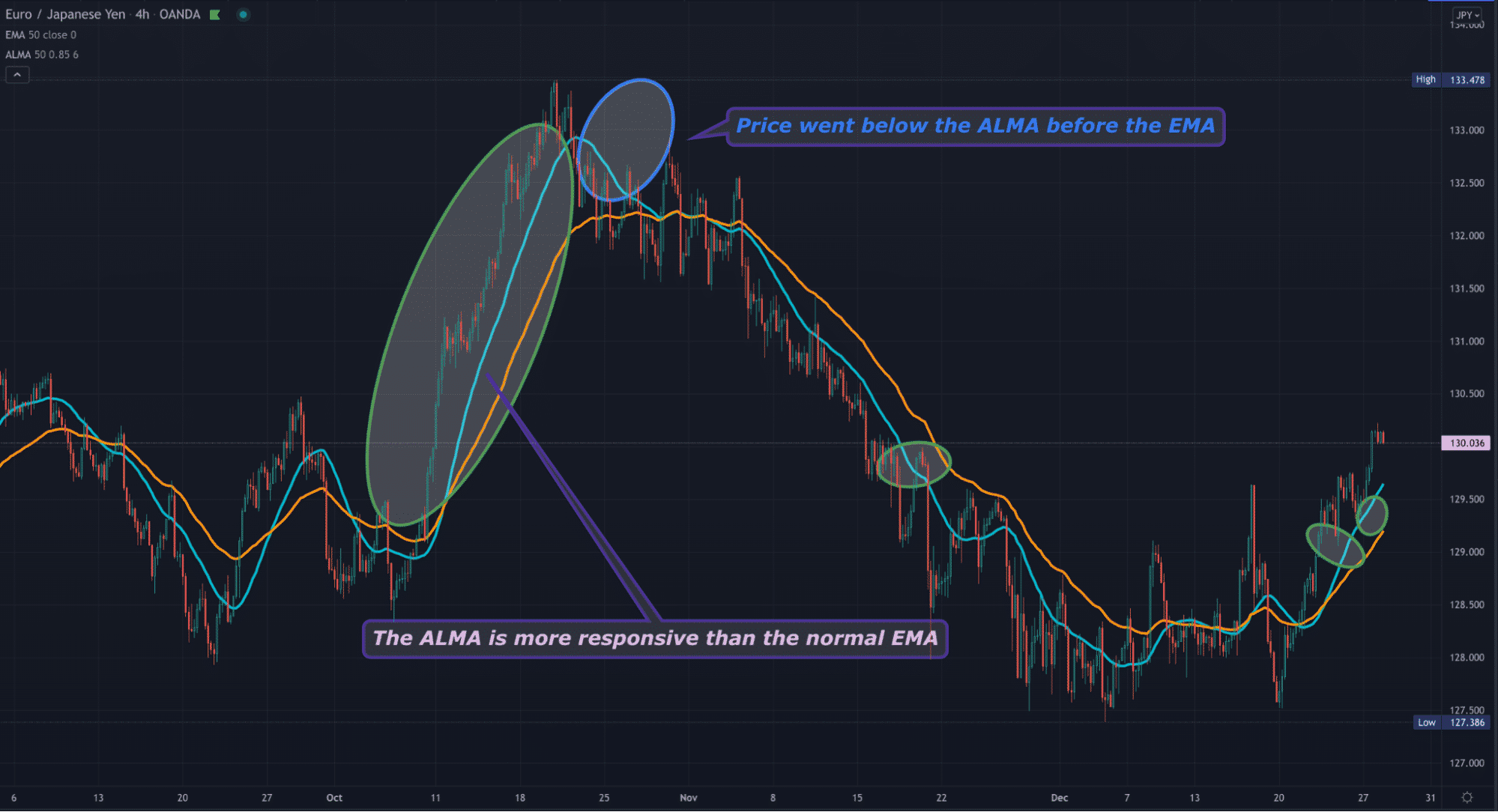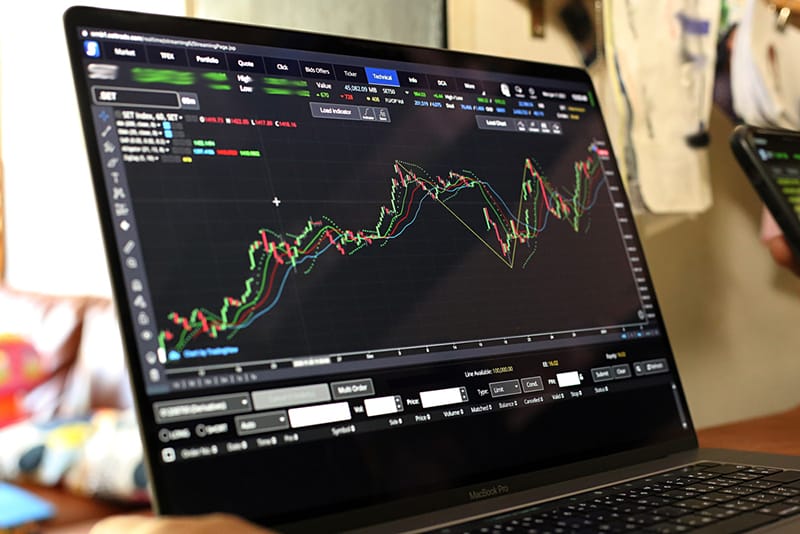Overview
In forex, we have several kinds of Moving Averages like simple, exponential, smoothed, weighted, volume-weighted, and other custom types like Hull and Kaufman.
One kind which is probably unfamiliar with the majority is the Arnaud Legoux Moving Average indicator (ALMA), built to combat the shortcomings of its predecessor, namely that of being noisy and not reactive enough.
Due to its inherent structure, many enthusiasts believe the ALMA presents more reliable trading signals than your typical Moving Averages. So, what sets the ALMA apart from its predecessor; how exactly can traders use this indicator in forex? Let’s find out in this guide.
What is the Arnaud Legoux Moving Average?
Not much seems to be known on the prior development of this indicator. However, most research confirms this indicator was developed by Arnaud Legoux (its namesake) and Dimitrios Kouzis Loukas in 2009.
A Moving Average is represented by a constantly updated ‘moving’ line reflecting the ‘average’ price (usually the closing) of an instrument over a specified number of days.
This simple data analysis allows traders to identify the overall trend within a particular time frame. When the price is above the Moving Average, we expect higher prices; when the price is below the Moving Average, we expect lower prices.
The two most commonly used Moving Averages are the simple (SMA) and exponential (EMA). One isn’t necessarily better than the other as they differ primarily in their sensitivity to the average prices.
The SMA gives equal weighting to prices, while the EMA assigns more importance to recent prices as it uses a smoothing factor in its calculation. If you’ve used Moving Averages for any length of time, you’ll know that a shorter-period line is more responsive but quite ‘choppy.’
Conversely, a higher period is less ‘choppy’ but much slower to confirm a trend. Hence, these are some drawbacks to using Moving Averages as traders can get many false signals. The ALMA aims to combat the problems of responsiveness and smoothness in Moving Averages because of its unique composition.
Components of the ALMA
Legoux and Loukas were inspired tremendously by something known as Gaussian filtering in designing this indicator. In simpler terms, this mechanism is widespread in signal processing to effectively remove noise and detail to produce a smoother result.
As expected, the ALMA is calculated differently from most Moving Averages. More specifically, the main Moving Average in the ALMA is applied twice, from left to right and then in the opposite direction.
This creates what is called the combo line, which has a Gaussian offset of 0.85 by default. Moreover, a sigma or standard deviation of 6 is applied. Therefore, the ALMA has three components as such:
- Window (the period, which is 9 by default)
- Offset (0.85)
- Sigma (6)
Of course, many of these concepts are pretty complex for most to understand. Fortunately, you don’t need to concern yourself with the finer details of the ALMA. You can adjust any of the settings with most trading software to your preferences.
However, most traders would probably alter the period to the popular numbers like 50, 100, or 200 depending on their time frame reference and trading style. Of course, it’s worth seeing the difference between the ALMA and an ordinary EMA as on the chart below.

We’ve set each Moving Average to a period of 50 on the EURJPY market, with the ALMA in blue and EMA in orange. While both averages seem quite similar, the ALMA reacts more closely to price as circled with the green ellipses.
You should note how close the ALMA travels near the price compared to the ordinary EMA. In the blue ellipse, we can observe the market went below the ALMA before the EMA. This would have provided traders with an earlier sign of a potential reversal, and this is what’s meant by the ALMA being more responsive.
Using the Arnaud Legoux Moving Averages
Like most Moving Averages, the ALMA is used primarily for identifying trend direction. The premise is simple; when the price is above the ALMA, the trend is considered bullish, and when the price is below the ALMA, the trend is deemed to be bearish.
Of course, things in forex are never so clear-cut. Yet, the ALMA can quickly provide traders with a directional bias, the core of any trading setup. With this information, one can combine the ALMA with other indicators like the Relative Strength Index (for momentum) to provide other confirmation factors.
Another way to use the ALMA is with a classic crossover system by combining two ALMAs, e.g., a 50 and 100-period or 5 and 10-period. Traders use crossovers as reliable entry triggers. Like other MAs, the ALMA is also useful in identifying dynamic support and resistance, which is more versatile than horizontal support and resistance.
Dynamic support and resistance can work when there’s an already established trend. Traders look to ‘buy the dips’ or ‘sell the rips’ by waiting for the price to return to the Moving Average.
When combined with price action patterns like pin-bars and hammers, dynamic support and resistance become a staple of safely entering into a move that’s underway. In short, the ALMA aids traders with identifying the prevailing trend, potential reversals, and dynamic support and resistance.
Final word
If you’re a Moving Average enthusiast, then you’ll undoubtedly find usefulness in the Arnaud Legoux Moving Average. This indicator was designed to enhance the smoothness and responsiveness of typical Moving Averages so traders could derive more reliable trading signals with predictive success.
Yet, despite the benefits, the ALMA is still technically a lagging indicator because it uses past data and produces a signal after the price has traveled a certain way. Therefore, it’s critical to never solely rely on the ALMA’s findings and combine your analysis with as many solid confirmation factors as possible.
